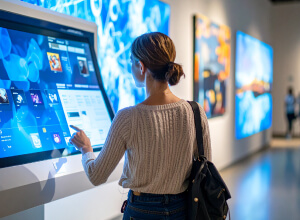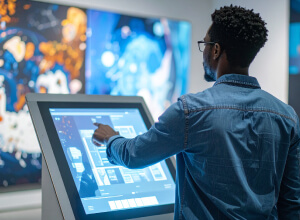Touch Screen Kiosk Content Creation Business Future-Ready

From a software perspective, here are some all-encompassing strategies that could help your kiosk content creation business stay resilient and future-ready through the industry rollercoaster
Introduction To Touch Screen Content Creation For Kiosks
How to keep your touch screen kiosk content creation business future-ready and resilient? Never before has this question meant so much with the world in the midst of unusual adversity that is altering the industry and signaling the need for creative change. If you pay attention to warnings and forecasts by experts or how your own touch screen content business performance is influenced by ever-changing socio-economic conditions, you know that nothing in how you go to market can remain unchallenged or unchanged. Countless stories of failed companies and others who have survived a series of industrial transformations and revolutions have taught us that companies must metamorphosize if to survive. But how do we achieve the "right" kind of metamorphosis? Truth be told, there is no one magic bullet. Circumstances are unsettling, and not all touch screen kiosk projects have the same use performance is influenced by ever-changing socio-economic conditions, you know that nothing in how you go to market can remain unchallenged or unchanged. Countless stories of failed companies and others who have survived a series of industrial transformations and revolutions have taught us that companies must metamorphosize if to survive. But how do we achieve the "right" kind of metamorphosis? Truth be told, there is no one magic bullet. Circumstances are unsettling, and not all touch screen kiosk projects have the same use.
That is why we would like to share practical insights from our experience as the provider of the premier interactive experience creation platform, Intuiface, which has played a trailblazing role in the ever-evolving world of the digital signage industry. From a software perspective, here are some all-encompassing strategies that could help your content creation business for touch screen kiosks stay resilient and future-ready through the industry rollercoaster
1. Reduce cost for your kiosk business (without giving up on quality)
Stating the obvious, one of the trickiest subjects that any business deals with is keeping cost down. For agencies and service providers, big or small, lower-cost delivery often means a more significant margin and a selling point. For end-user brands and organizations, lower-cost means less financial risk. That is why when launching new touch screen kiosk projects, many start by looking at the price tag of key investments: hardware and software. Hardware often falls into commodity buckets and thus price comparison can be fairly straightforward. Software? Not exactly. The price tag often does not fully represent the actual delivered value and quality of the outcome.

You are not mistaken that the subject here is still cost. But you can’t neglect the fact that quality and price are inseparable factors which together translate into “value”.
You will achieve a successful content creation delivery business not by lowering the value, but rather by raising it.
The only thing that matters to users is the quality of their experience and the worthiness of the time they spend with installations, not how much you initially saved on the software. The cost outlay of the original investment must be balanced with user satisfaction as it affects the results and the ability to realize profits. Keep this trade-off in mind when the next time you go software shopping for your content creation business.
Does it give you the design freedom?
A touchscreen kiosk that entices and engages needs to be visually appealing, memorable, and effective. Make sure to find kiosk software with no limitations on important design factors such as layouts, screen size, media formats, visual effects, or the number of scenes.
Is it a CMS or a DXP? (They are NOT the same)
Often Content Management Systems (CMS) or Digital Experience Platforms (DXP) are found in the same virtual aisle, giving a false impression that they are two of the same. Don’t rush into comparing the price tags before you understand their differences and your needs.
A CMS is a standalone back office system that stores and orchestrates the “push” of content (images, videos, and text) to displays. While most kiosk software options are of this nature, a DXP goes further by helping deployers to produce a cross-channel experience that unifies the web, mobile apps, and on-premise digital installations.
A CMS focuses on the content creation, management, and deployment cycle that is audience independent, while a DXP maintains consistent communication across channels by accessing and presenting personalized information when feasible.
Chances are, even if your strategies today are not pinned on engaging with visitors to a personalized level, you will soon come across signs showing that they will expect it, or turn away from the lack of it. So keep this vision in mind and invest in the right platform for the correct value. Also, do that at the outset of a project because building a personalized experience does not happen overnight.
Is the kiosk platform modern and user centric?
Ideally, you’d possess a modern and user-centric kiosk software with a sophisticated toolset that empowers you to do more things using simple approaches. Make sure it feels intuitive in your hand when you add and move around content like 3D models, Flash animation, pdf’s, videos, etc. See if the kiosk platform has features like drag-and-drop, automatic layout setting, and pre-made design assets.

Is data security part of the package?
When creating and deploying a personalized kiosk experience, you inevitably access, manipulate, share, and display personal data, much of which could be sensitive and private. In a world where privacy concerns and demand for data-driven digital experiences cross paths, digital content deployers are responsible for securing that data. Improve data security and communicate about it to gain visitors’ trust, and minimize your own risk of potential data breaches. Especially for agencies and service providers, protecting data by adopting strict information security standards is critical and creates a trusting relationship with enterprise customers. How to verify whether software accounts for data security? See if it complies with information security standards such as ISO 27001. As of today, Intuiface is the only digital signage company to be certified for its compliance with this globally recognized information security standard.
2. Time is gold
A typical touchscreen kiosk project will have a cycle of planning - creation - prototyping and editing - deployment – device management.
You would want to keep this process as short as possible because time equals money. If you are providing your service to an end-user, shorter delivery time means higher customer satisfaction and retention. Here are some ways to optimize project time management.
Do not rely on a single centralized content management system.
Work with a Digital Experience Platform that enables you to dynamically pull content (videos, images, and text strings) from a network of external content repositories. This way, you can avoid having to manually manage information within a siloed system, which could also require reconstructing the design and layouts each time you make updates. By having the freedom to work with multiple web services, cloud storage options, and content management systems as dynamic content sources, you can add or retrieve information in real-time as often as you require outside of the project.
Keep collaboration and sharing simple.
You may need to iterate through frequent modifications and prototypes before delivering the final product.
Use software that allows you to share your work easily and iterate quickly. (Click here to learn about Intuiface’s sharing by URL)
Creation platforms that cheat your way out of coding
Creating highly interactive, gratifying, and purposeful experiences doesn’t have to be time-consuming or resource exhausting, whether because it requires complicated coding skills or outsourcing specialists. With the quality goal in the back of your mind, equip your team with a no-coding creation platform that enables you to stay agile and future-ready beyond technical barriers. There is no shame in being resourceful with your software use! Check out Intuiface, no-coding kiosk software.
3. Go beyond touch
Adopt Interactivity beyond touch
Thanks to the extraordinary penetration of mobile phones, tablets, and the enormous volume of existing touchscreen kiosks and signage deployment, we’ve arrived at the point where getting past the convenience of touchscreens seems close to unimaginable. However, we can’t predict when people will turn away from touchscreen displays seeing how people’s attitudes toward public-facing touchscreen use have taken a significant hit by the recent pandemic. Keep touch, but consider also adopting touch-alternative options in parallel to gain a competitive edge and to future proof your touchscreen kiosk. The good news is that there is a world of alternative solutions, and it’s easier than you think to adopt them.
Below are some of the most used on-screen touch alternatives.
- RFID/NFC: RFID/NFC systems uniquely identify tagged items. Example uses include Lift and learn and Tangible objects.
- Voice control: Technology that captures information or commands via the spoken word. Alexa, Cortana, Siri, Google speech recognition. Do you use one of these?
- Beacons: Conceptually, just a variant of RFID/NFC. The underlying tech is different but the result is the same.
- QR or Bar Codes: Enables visitors to either bring objects to be scanned or scan displayed codes in order to view info on their phones.
- Gesture: Start-ups (like Gestoos, Ultraleap) and the big guys (see Google Soli) continue to work at enabling untrained bystanders to interact via hand motion.
- Internet of Things: Here we're talking about the facilitation of interaction with connected objects, using a screen (for example) as a mediator between the audience and the device.
- Computer vision: Use of camera-initiated pattern matching to anonymously identify gender. age range, and more. See options like Sightcorp, Intel OpenVINO, Quividi
- Eye tracking: Amazing but true, there is tech enabling businesses to track where eyes are focused, identifying hot spots of attention.
4. Adopt analytics as soon as you can.
Read our free ebook What You Need To Know About Analytics for Digital Signage for a complete guide on understanding Analytics for digital signage.
Let's say by now we all agree that the strategies to keep your touch screen kiosk business resilient and future-ready is centered around offering highly interactive and personalized kiosk experiences. Then there is one other inevitable action point for you if you still haven't done it: adopt analytics. Once you move from passive content deployment to incorporating more advanced interactive technologies such as mentioned above, you will have the ability to adopt an analytics platform to collect mine an enormous volume of useful data from all those visitor interactions made on the kiosk installation. This collected data can help you:
- Create and deploy a personalized experience
- Evaluate and improve your business beyond the kiosk performance itself
- Capture new opportunities
Keep in mind, the mere act of collecting data is insufficient. How we process collected data from various points of the visitor journey, and how to effectively visualize them to derive conclusions is just as important. The good news is that with extensive analytics platforms like Intuiface Analytics, you can significantly change the way you manage and improve kiosk performance.

Operating without analytics is like driving in the dark. Turn on those headlights!





